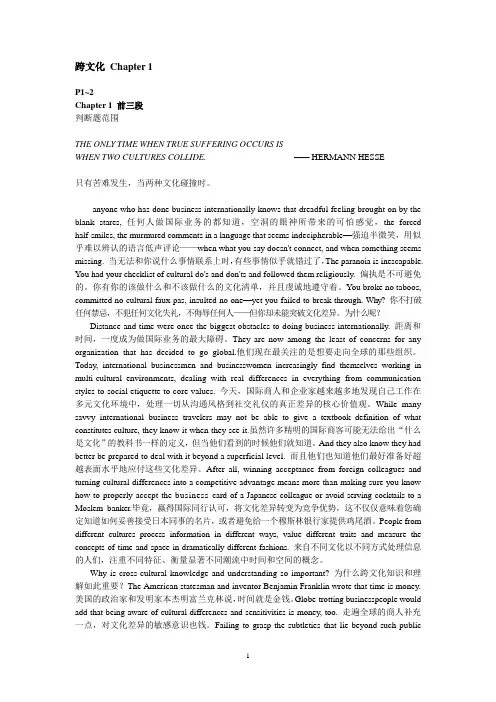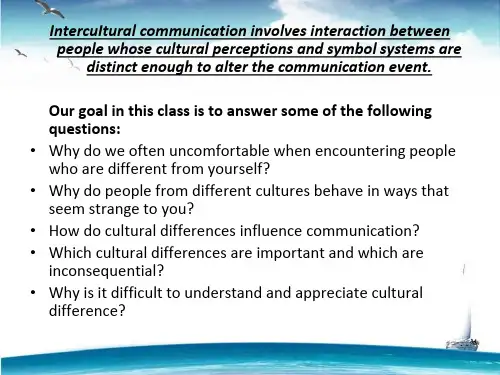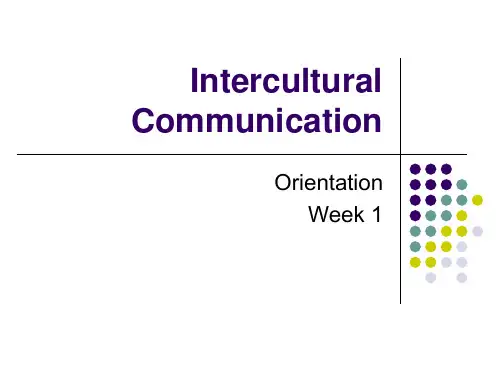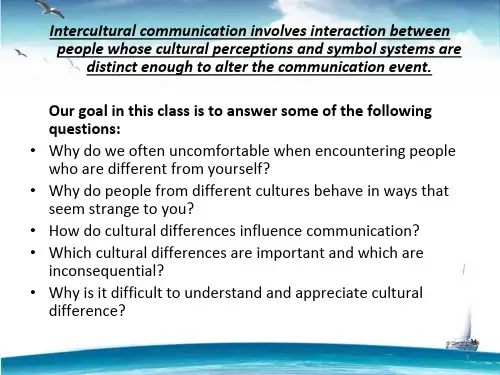跨文化交际实训Chapter1Culture,Communication
- 格式:pdf
- 大小:6.38 MB
- 文档页数:50


跨文化Chapter 1P1~2Chapter 1 前三段判断题范围THE ONLY TIME WHEN TRUE SUFFERING OCCURS ISWHEN TWO CULTURES COLLIDE. —— HERMANN HESSE只有苦难发生,当两种文化碰撞时。
anyone who has done business internationally knows that dreadful feeling brought on by the blank stares,任何人做国际业务的都知道,空洞的眼神所带来的可怕感觉,the forced half-smiles, the murmured comments in a language that seems indecipherable—强迫半微笑,用似乎难以辨认的语言低声评论——when what you say doesn't connect, and when something seems missing.当无法和你说什么事情联系上时,有些事情似乎就错过了,The paranoia is inescapable. You had your checklist of cultural do's and don'ts and followed them religiously.偏执是不可避免的。
你有你的该做什么和不该做什么的文化清单,并且虔诚地遵守着。
You broke no taboos, committed no cultural faux pas, insulted no one—yet you failed to break through. Why?你不打破任何禁忌,不犯任何文化失礼,不侮辱任何人——但你却未能突破文化差异。
为什么呢?Distance and time were once the biggest obstacles to doing business internationally.距离和时间,一度成为做国际业务的最大障碍。





Chapter One A Brief IntroductionⅠ. Introduction1. Questionnaires (extra hand-outs)These two questionnaires are presented as the warming up exercises to check how the students can handle communications in daily practice. Discuss the communicative problems with students and analyze the relevant reasons. Then ask the students some questions.2. Lead-in Questionsⅰ. What do you usually communicate with other people?ⅱ. Have you ever been embarrassed when talking with strangers? Why is that?ⅲ. Do you know how to communicate with foreigners?Tell their conversation partner something concrete and significant about themselves.Look for common interests and shared opinions for a more solid basis of relationship.Individualize the foreigners.ⅳ. Have you come across the cultural shock in communication?3. DiscussionDiscuss the different ways of cultural communication and found out the reasons by analyzing some cases.4.Introduction of Intercultural Communicationa.Cross-cultural communication is also called intercultural communication. “Intercultural Communication”is communication between members of different cultural backgrounds. Intercultural Communication involves different perceptions, attitudes, and interpretations. Intercultural Communication is an interdisciplinary field which includes anthropology, cultural studies, psychology, and communication.Anthropology(from the Greek word ἄνθρωπος, "human" or "person") consists of the study of humanity (see genus Homo). It is holistic in two senses: it is concerned with all humans at all times and with all dimensions of humanity. In principle, it isconcerned with all institutions of all societies.Cultural studies combines sociology, social theory, literary theory, media theory, film/video studies, cultural anthropology,philosophy and art history/criticism to study cultural phenomena in industrial societies. Cultural studies researchers often concentrate on how a particular phenomenon relates to matters of ideology, race, social class, and/or gender.Cultural studies concerns itself with the meaning and practices of everyday life. Cultural practices comprise the ways people do particular things (such as watching television, or eating out) in a given culture. Particular meanings attach to the ways people in particular cultures do things.Psychology is an academic and applied field involving the study of the human mind, brain, and behavior. Psychology also refers to the application of such knowledge to various spheres of human activity, including problems of individuals' daily lives and the treatment of mental illness.For instance, if you talk with your American teacher, intercultural communication takes place. If you interact with a Japanese student, there is intercultural communication.It takes place everywhere.Intercultural communication dates back to thousands of years ago. A long time ago, when people started intermingling with each other, when people were having trade relations with each other, there was intercultural communication. A very good example is the Silk Road.b. Reasons for us to learn cross-cultural communication:Modern means of communicationNow jet planes fly everywhere. It used to take a month to travel from Shanghai to Los Angeles. But now, it takes only twelve hours. It is much easier for people to move from one country to another. People of different countries and races get together much oftener than before. Besides, people get in touch with each other in various ways, including the telephone, the internet, the satellite, etc.Sophisticated communication systems have also helped to increase intercultural communication.Global villageThis means multinational companies now operate in many countries in the world.They employ people of different ethnic groups and of different countries.Actually some multinational companies make a point of employing people from different countries. They don't use people from just one country because their company is a multinational company and they want to use people from different countries. People everywhere need to learn about other cultures. They need to know their neighbors. They need to know how to get along with them and how to solve problems that inevitably arise. To do this it is necessary to learn how to communicate across cultures or how to do culture.Mass migrationMillions of people now move across national boarders every year. All these contribute to the fact that intercultural communication is now a daily occurrence.Its importance is now being recognized by an increasing number of people. The United States is a “melting pot”. Many young Americans no longer accept the melting pot image, because it includes the idea that people lose their home cultural identities, traditions, and values when they become Americans. We now replace the melting pot with mosaic. A mosaic is made up of diverse materials or elements that keep their original character when they are combined to create a new design. This new image expresses the idea that part of the American way of life is respect for cultural diversity.c. ApplicationIt can be applied in the training of business executives and technicians, particularly for those who go overseas. And they have to encounter a lot of cultural problems, so they have to be trained before they are sent overseas.Otherwise they would not be able to work effectively.And then there is the training of new immigrants and foreign students. This is done both in the United States, and also in countries like Australia.And then there is multicultural education because at American schools and also at some of the British schools, the pupils, the students are from different ethnic groups, and they have different cultures. So they have to be given what is calledmulticultural education. And also in foreign language teaching, intercultural communication is very important. Finally, it is useful for improving general cultural awareness.Ⅱ. Communication1.Types of Communicationa)human communicationHumans communicate in various ways. We speak, use body languages,intentionally or unintentionally communicate each other in either formal orinformal ways. (formal&informal, oral&written, intentional&unintentional,verbal&nonverbal)b)animal communicationResearchers have discovered that animals share with humans a number ofcharacteristics, including those associated with attraction and mating,territoriality, rivalry and play, familial ties, colony organization, division oflabor, and numbers of other traits that we once assumed were uniquely“human”. (animal language)c)human-animal communicationnon-word soundbody languaged)human-computer communicationInformation that was once conveyed verbally through stories and myths inancient times is now transmitted through high-tech media. (artificiallanguage)e) machine-machine communicationartificial language: codes2. Compare and ContrastGreetingsDialogue 1Friend: Hi, George, have you met Bill?George: No, I haven’t. Hi, Bill.Bill: Hi! How ya doing?Dialogue 2香港人到現在一見面還是會問:“食咗飯未?”意思就是吃過飯了嗎。

Chapter 1 CultureI.定义Culture(from intellectual perspective):从知性角度定义文化:作为整体的人类智力成就的艺术和其他表现Culture(from anthropologic perspective):从人类学角度定义文化:文化有清晰和模糊的行为模式构成,这些模式通过符号获得并传播,这些符号有人类群体的特别成就构成,包括具体的人工制品。
文化的基本核心由传统思想和与其相关的价值观构成。
Culture(from psychological perspective) : 从心理学角度定义文化:文化是使一个人类群体成员区别于其他人类群体的思维的总体规划。
Culture(from sociological perspective):从社会学角度定义文化:文化是一种可习得的,基于群体的认知模式——包括言语与非言语符号,态度,价值观,信仰和非信仰系统以及行为。
Culture(from intercultural communication perspective):从跨文化交际学角度定义文化:文化是个人和群体在种族发展过程中所获得的知识,经验,信仰,价值观,行为,态度,阶级,宗教,时间观,角色,空间观和艺术品的集合。
Culture Identity: 文化身份:认为自己归属于某一文化或民族群体的感觉。
Subculture亚文化:指存在于主流文化中的文化,其划分通常基于经济地位,社会阶层,民族,种族或地理区域。
Co-culture 共文化——指具有独特的交际特征,感知特点,价值观,信仰和行为,区别于其他群体,社团以及主流文化的群体或社团。
Subgroup 亚群体——相对于亚文化和共文化群体,亚群体通常规模不大,也不一定有文化群体时代相传积累的价值观念和行为模式。
Chapter 2 Communication and Intercultural Communication1. Sender/Source信息发出者/信息源:指传递信息的人2. Message信息:只引起信息接受者反应的任何信号。



Chapter One:Culture and Communication1.The Importance of Learning about CulturesCase 1. Read the following case and try to explain the underlying reason.Case 1. The following case involves an American businesswoman and a British Businessman.“We seeme d to get along great on the telephone. It was a relief after several years in Eastern Europe to actually be doing business with the British. At least we spoke the same language,” says the American businesswoman. “We thought alike. I trusted him.”All went well until the American traveled to London to meet face-to-face with her British colleague to sign a research and development contract. The first meeting did not go well. “ There was something that didn‟t seem right,” she says. “Throughout the presentation none of the Brits, not even the guy I had developed a phone relationship with, would look us in the eye. It was like they were hiding something.After a lot of internal discussion, we decided to sign the contract, but many of us still felt uneasy. Even wh en we talked on the phone later I just couldn‟t get the failure of them to look me in the eye out of my head. It almost ruined the relationship and sunk the deal.”2.Understanding Culture2.1 The Definition of Culture(p2-p4)What’s culture?2.1 Larry A. Samovar and Richard E. Porter’s Definition of Culture (p4):The deposit of knowledge, experience, beliefs, values, attitudes, meanings, hierarchies, religion, notions of time, roles, spatial relations, concepts of the universe, and material objects and possessions acquired by a group of people in the course of generations through individual and group striving.文化的定义:文化是一个大群体在代代相传中,通过本人和集体的努力获得的知识、经验、信念、价值、态度、角色、空间关系、宇宙关系的积淀,以及他们获得的全部物质的东西。